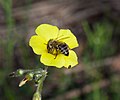 | Africanized bee, also known as the Africanized honey bee (AHB) and colloquially as the "killer bee", is a hybrid of the western honey bee (Apis mellifera)... 56 KB (6,413 words) - 21:50, 1 April 2024 |
 | The honey bee life cycle, here referring exclusively to the domesticated Western honey bee, depends greatly on their social structure. Unlike a bumble... 7 KB (707 words) - 13:50, 10 February 2024 |
 | Swarming is a honey bee colony's natural means of reproduction. In the process of swarming, a single colony splits into two or more distinct colonies... 17 KB (2,432 words) - 03:00, 10 April 2024 |
 | Varroa destructor (redirect from Bee mite) feeds on honey bees and is one of the most damaging honey bee pests in the world. A significant mite infestation leads to the death of a honey bee colony... 38 KB (4,443 words) - 21:14, 27 April 2024 |
Diseases of the honey bee or abnormal hive conditions include: Varroa destructor and V. jacobsoni are parasitic mites that feed on the fat bodies of adult... 66 KB (7,646 words) - 10:28, 15 April 2024 |
 | The East African lowland honey bee (Apis mellifera scutellata) is a subspecies of the western honey bee. It is native to central, southern and eastern... 26 KB (3,184 words) - 01:55, 28 April 2024 |
 | Apis cerana (redirect from Chinese honey bee) Apis cerana, the eastern honey bee, Asiatic honey bee or Asian honey bee, is a species of honey bee native to South, Southeast and East Asia. This species... 41 KB (5,105 words) - 15:36, 23 April 2024 |
 | Honey is a sweet and viscous substance made by several species of bees, the best-known of which are honey bees. Honey is made and stored to nourish bee... 115 KB (12,894 words) - 12:26, 23 April 2024 |
 | For bees, their forage or food supply consists of nectar and pollen from blooming plants within flight range. The forage sources for honey bees are an... 3 KB (428 words) - 09:01, 24 January 2022 |
 | Colony collapse disorder (redirect from Honey bee depopulation syndrome) worker bees in a honey bee colony disappear, leaving behind a queen, plenty of food, and a few nurse bees to care for the remaining immature bees. While... 138 KB (15,458 words) - 13:36, 26 April 2024 |
The Maltese honey bee, Apis mellifera ruttneri, is a subspecies of the western honey bee, endemic to the Maltese islands which are situated in the Mediterranean... 11 KB (1,259 words) - 19:19, 4 March 2024 |
 | List of Apis mellifera subspecies (category Western honey bee breeds) Apis mellifera, the western honey bee, has many subspecies. The most recent taxonomic revision in 1999 recognized 28 subspecies and three additional subspecies... 14 KB (1,609 words) - 22:49, 30 March 2024 |
 | A round dance is the communicative behaviour of a foraging honey bee (Apis mellifera), in which it moves on the comb in close circles, alternating right... 10 KB (1,392 words) - 06:21, 1 March 2024 |
 | Apis dorsata (redirect from Giant honey bee) Apis dorsata, the rock bee or giant honey bee, is a honey bee of South and Southeast Asia. They are typically around 17–20 mm (0.7–0.8 in) long and nests... 26 KB (3,332 words) - 11:06, 17 April 2024 |
 | Asian giant hornet (redirect from Bee ball) larger insects, colonies of other eusocial insects, tree sap, and honey from honey bee colonies. The hornet has a body length of 45 mm (1+3⁄4 in), a wingspan... 95 KB (10,127 words) - 03:33, 29 April 2024 |
 | Stingless bees (SB), sometimes called stingless honey bees or simply meliponines, are a large group of bees (from about 462 to 552 described species)... 104 KB (11,615 words) - 21:49, 8 April 2024 |
 | capped drone brood and either freezing the brood comb or heating it. Western honey bee life cycle Drones Club Nickel, J. (2001). Mathematics: Is God Silent... 15 KB (2,093 words) - 10:16, 2 May 2024 |
 | Waggle dance (redirect from Bee dance) in beekeeping and ethology for a particular figure-eight dance of the honey bee. By performing this dance, successful foragers can share information about... 33 KB (4,072 words) - 06:18, 1 March 2024 |
The Buckfast bee is a breed of honey bee, a cross of many subspecies and their strains, developed by Brother Adam (born Karl Kehrle in 1898 in Germany)... 20 KB (2,620 words) - 10:51, 16 April 2024 |











